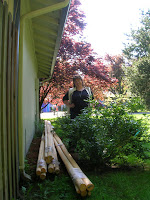 Fireplace, kitchen, office and bed. Oh, and library. Sleeping in the tipi is snug and cozy. It's a soft environment (except when I broke my toe on a rock one night.) The spot between the bed and the rocks is where my dog chooses to sleep.
Fireplace, kitchen, office and bed. Oh, and library. Sleeping in the tipi is snug and cozy. It's a soft environment (except when I broke my toe on a rock one night.) The spot between the bed and the rocks is where my dog chooses to sleep.It's a comforting feeling, having her at my side.
It's beautiful to have a small fire in the tipi. It glows from the outside, and inside, with the smoke flap set properly, the smoke goes straight up. It is not a smokey environment at all. As I've learned, it requires a nice hardwood in small pieces, so that the fire is mostly flames. Keep it small. The tipi gets very warm and the hot stones keep it warm for hours after the fire goes out.
I had to take half the lacing pins out to get the couch in. Arg. But it's worth it, to have a cozy place to sit and knit, read and write.

I have to thank my friends for all their help. My daughter for helping set up the tipi even after she just flew in from college, the neighbors/property owners who have been awesome in every way -- making a road and landing pad, setting up the tipi, lending me freezer space, cutting firewood (and teaching me to split it!), wonderful company, and my friend S, who had been one in a million.
The neighbors' dog, a giant Golden Retriever male named Riley, comes and visits. He likes to take my dog's dead squirrel toy and hide out behind the sofa.
















